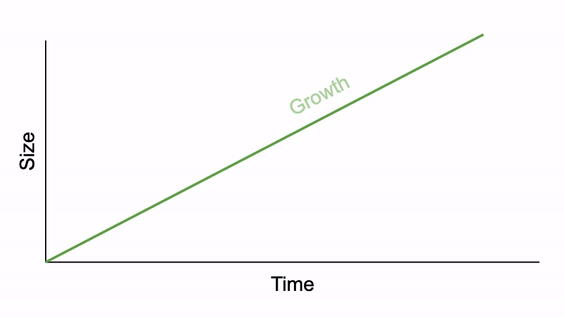A personal note: These are my learnings from consulting, being part of a growth team at Postmates, then leading growth at Panoply, so hopefully, it’s insightful. This post has been idling in a Google Doc for weeks because I couldn’t dedicate the time to complete it. So instead of never completing a single long post, I decided to break it into posts. This way its easier to publish and hopefully easier to read. If you want to catch the next two posts on “Your Work” and “Your Team” sign up here.
Growth is simple. It is just a measure size over time.
You can grow anything— visitors, users, subscribers, customers, revenue, profit—it doesn’t matter. If you can measure it, you can put it on a timeline, and you can grow it.

The fun starts when you start trying to accelerate the rate of growth. Luckily, since growth is just the increase in size over time, you can simplify this problem down to reducing the amount of time it takes to get to a given size. And because the growth role in a startup is all about… growth, you can never move too fast. The question is, how?
This is where scaling your self comes in. By “scale,” I mean specifically increasing capacity (the ability to do more in the time you have) and competence (the ability to just do more). This is how I would break down the ways you can scale yourself to accelerate growth. (part 1 of 3)
Some of the later recommendations assume you have cash to spend or personal time that you are willing to devote to personal development. But to begin with, the list is prioritized in a way that starts with things that everyone can do and continues to things that are resource-dependent.
Do less.
If you’ve ever found yourself at 3 pm with 40 browser tabs open and not a single thing crossed off your to-do list, this one is for you. You know its much easier to join a watercooler brainstorming session or get lost in a Google search rabbit hole than to align stakeholders, reply to the mile-long partner email threads, and dig into the tedious details of a campaign launch. This one is all about self-discipline.
By “do less”, I mean “do less of the things that take time but don’t drive growth.” Since growth is a factor of time, it is your most precious commodity—especially if you’re running on a lean budget. Wasted time stunts growth.
This may not seem like a revelation but when it comes to self-discipline, it comes down to honesty. You have to be honest with yourself when you ask yourself, “Is this activity driving growth faster than all the other activities I could be doing?”
If you struggle with this type of introspection, ask yourself, what would the “Jerry Rice / Greta Thunberg / Steve Jobs of growth” do? The answer is probably something way more badass than, “continue scrolling through Instagram.”
But while self-discipline is great to keep you driving fast, prioritization is what keeps you driving toward success.
Prioritize. Don’t confuse activity for productivity.
In the previous section, I eluded to what I’ll refer to as the opportunity cost of time. The question, “Is this activity driving growth faster than all the other activities I could be doing?” considers that every activity takes some time but each activity accelerates growth at a different rate.
For example, if you are scrolling through Instagram, you are increasing your rate of growth by roughly 0. But if you spend the same time launching a landing A/B test you might see a measurable increase in your rate of growth. If you spend your time onboarding an expert A/B testing freelancer, you’re likely to have a compounding effect!
How do you know what to prioritize?
First, you will need to be very familiar with you “one metric to rule them all.” As much as I’d like to dive into the discussion about metric selection and validation, instead I’m going to recommend reading “Lean Analytics.”
There is always “the one metric” at the bottom of the funnel and most often it relates to revenue. Mature growth programs will have a good sense of what the funnel looks like above this final metric. And growth programs that are moving at full speed are able to evaluate levers in terms of how they impact growth.
If both of these ideas seem foreign to you, you better start building a funnel and quantifying the effect of various levers against your funnel. In other words, consider how things like keyword expansion, link building, content creation, landing page testing, etc. affect conversion rate through your funnel.
Once you know how powerful the different levers in your growth program are, you can start to determine how much time it will take to move a lever (and corresponding metric) a given amount. Then you can ask, “Is this activity driving growth faster than all the other activities I could be doing?”
The opportunity cost of time
I love dealing with the metaphysics of this discussion. As I laid out above, every period of time can be evaluated by its potential to accelerate growth. In addition, every activity requires an amount of time to accomplish. And finally, every activity effect can vary in the eventuality and duration of its effect. Time, this single dimension, has a three-dimensional impact on growth!
While it can be valuable to consider the dimensions of time, the last thing you want is analysis paralysis. That is why I recommend a universally helpful and satisfyingly simple tool: Dwight D. Eisenhower’s prioritization framework.
Dwight D. Eisenhower’s prioritization framework measures everything that could be done on two axes: urgency and importance. Let’s break it down in the context of growth.
Urgent unfortunately often means broken. This could be things like robots.txt files, shopping carts, links in email templates, or sign up forms. Every minute that these things stay broken, growth is probably decelerating. Urgency can also relate to time-sensitive campaigns that relate to external events or product/feature releases that must be prioritized.
Important things are generally measured against their impact on the “metric to rule them all.” You can generally gauge importance by asking “if I build/launch/do this thing, how will it affect growth in the next week/month/year?” (Consider the tradeoff in the week/month/year timeframes. Don’t always skip SEO in favor of quick response email or push campaigns.)
Next time you have to decide between updating a tired email template and writing a spec for a high-potential SEO feature, ask yourself, which will drive the most growth today and into the future. If your dev team has time to fill, perhaps pause the emails and give them a spec. If your “Welcome“ email is broken, fix it quickly and then deliver the spec.
A word of caution
As someone who clearly has a tendency to overanalyze things, I have one small word of caution: don’t let yourself fall into the trap of analysis paralysis. The 80% rule often applies to prioritization too. If you spend half your day trying to figure out what to do first, just call it a tie and get both things done.
It’s your time
I hope this discussion brought up some new ideas for you. If you disagree or notices something that is not included, please leave a comment and build on the discussion.
If your company is in the early stages of growth and want to discuss how to sharpen your focus and accelerate growth, contact me on GrowthMentor. I love sharing what I’ve learned from my experience. As you’ll find in part 3, often mentorship is the biggest growth accelerant.
If you want to stay tuned for parts 2 and 3 sign up to receive the posts in your inbox. (no spam, just posts)

